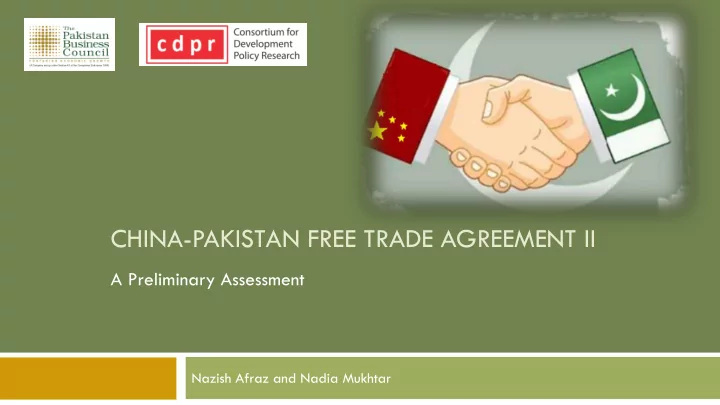

CHINA-PAKISTAN FREE TRADE AGREEMENT II A Preliminary Assessment Nazish Afraz and Nadia Mukhtar
CPFTA 1: Trade with China has increased far more than that with other countries… Pakistan’s trade following CPFTA1, 2007 -2018, in USD bn 2007 2018 Growth 2017-18 (%) Exports 0.6 1.8 196 China Imports 4.2 14.5 249 Exports 17 20 16 Rest of the world (excluding China) Imports 28 46 60 Source: ITC Trademap
..shifting further the higher growth trajectory that was there even before the FTA Growth in Pakistan's exports 200 180 160 140 120 100 % 89 pp 200 pp 80 60 40 20 0 2003-2007 2007-2011 Exports to China Exports to word minus china
CPFTA 2: Export lines distributed by tariffs in China 7000 6178 Number of tariff lines, by year 10 of FTA 6000 5000 4000 Phase 2 2,058 out of 8,238 will face tariffs by year 10 3000 2000 778 1000 395 294 226 203 97 56 3 6 0 0% 0-5% 5% 5-10% 10% 10-20% 20% 20-30% 30% >30%
Breakdown of the 8238 tariff lines in CPFTA 2 Pakistan exports to Pakistan exports China imports No. of Tariff lines China Priority 1 399 ✔︐ ✔︐ ✔︐ Priority 2 1424 ✔︐ ✔︐ Priority 3 5378 ✔︐ Non-priority 1036 Total 8238
The large majority of tariff lines now face no duties in China 90 % of CPFTA2 tariff lines, by year 10 80 70 60 of CPFTA 2 50 40 30 20 10 0 Products China doesn't import Priority 1 Priority 2 Priority 3 0% 0-5% 5% 5-10% 10% 10-20% 20% 20-30% 30% >30% Source: Author’s calculations using Ministry of Commerce data for CPFTA tariffs and ITC Trademap for trade data. All trade data is for 2018
CPFTA 2: Distribution of tariff access improvements (Year 10) 100% Expressed as % of tariff lines in that category 75% 50% 25% 0% Priority 1 Priority 2 Priority 3 Products China doesn't import Compared to Phase 1 Same Better Source: Author’s calculations using Ministry of Commerce data for CPFTA tariffs and ITC Trademap for trade data. All trade data is for 2018
Tariffs are now at least as good as those for top competitors for over 80% of tariff lines 100% 90% 80% 70% 60% Worse tariff than top 50% Same tariff as top 40% Better tariff than top 30% 20% 10% 0% Priority 1 Priority 2 Priority 3 Priority 1 Priority 2 Priority 3 Phase 1 Phase 1 Phase I Phase II
Sum of China world imports 2018 (USD mn) CPFTA2, by parent 2-digit code Priority 1 product lines that have competitive access under 1000 1500 2000 2500 3000 500 Source: Author’s calculations using Ministry of Commerce data for CPFTA tariffs and ITC Trademap for trade data. All trade data is for 2018 0 Miscellaneous edible preparations Cotton Plastics & articles thereof Vehicles other than Sum of Chinese imports from world railway,parts thereof Footwear, gaiters and the like Optical, photographic, medical or surgical Electrical machinery, equipment & parts Raw hides, skins, leather Articles of iron or steel Number of codes Soap, organic surface- active agents Preparations of cereals, flour, or milk; pastry products Furniture; bedding, mattresses Aluminium and articles thereof Preparations of vegetables, fruit, nuts 0 2 4 6 8 10 12 14 16 No of codes (in each HS 2-digit tariff line)
Specific product examples from Pakistan’s Priority 1 list Tariff (CPFTA 1) Highest value trade Tariff faced by HVTP Tariff (CPFTA 2) partner (HVTP) Men’s cotton 14% Bangladesh 0% 0% ensembles Men’s shirts, other 8% Italy 6% 0% textiles nes Other frozen flat fish 8% USA 7% 0%
Impediments to expanding trade in these sectors Information Marketing Capacity and competitivenss Trade Facilitation Domestic supply chain Non-tariff barriers
Conclusion Phase II of the China Pakistan FTA provides a substantial improvement in tariff access for a range of Pakistani products in China Tariff access does not automatically translate into exports Pakistani firms and Government of Pakistan will need to address non- tariff impediments to maximise utilisation of the FTA
Recommend
More recommend